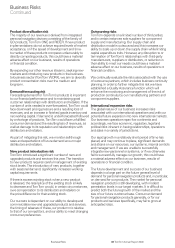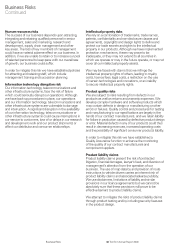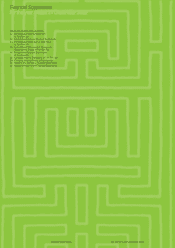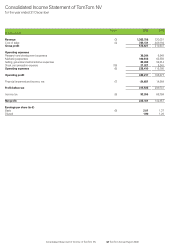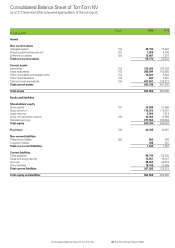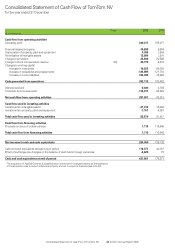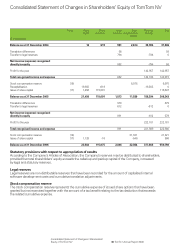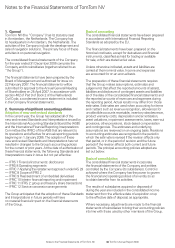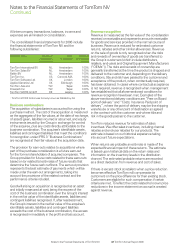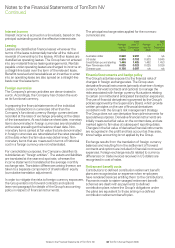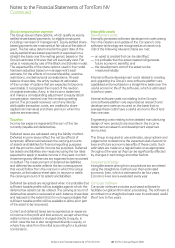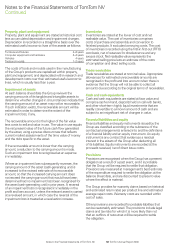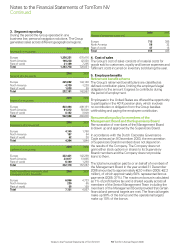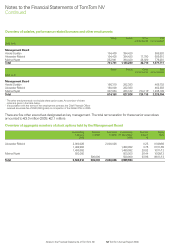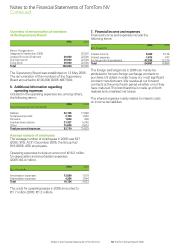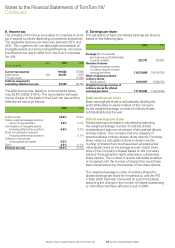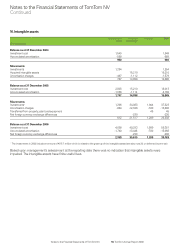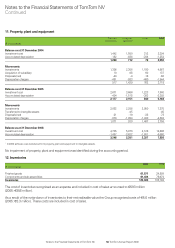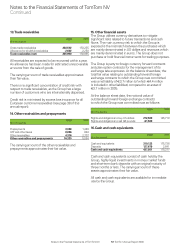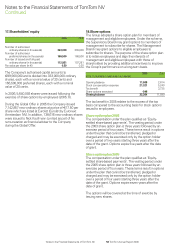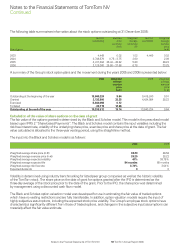TomTom 2006 Annual Report Download - page 51
Download and view the complete annual report
Please find page 51 of the 2006 TomTom annual report below. You can navigate through the pages in the report by either clicking on the pages listed below, or by using the keyword search tool below to find specific information within the annual report.49 TomTom Annual Report 2006Notes to the Financial Statements of TomTom NV
Stock compensation expense
The Group issues share options, which qualify as equity-
settled share-based payments, to eligible employees
including members of management. Equity-settled share-
based payments are measured at fair value at the date of
grant. The fair value determined at the grant date of the
equity-settled share-based payments is expensed on a
straight-line basis over the vesting period, based on the
Group’s estimate of shares that will eventually vest. Fair
value is measured by use of the Black and Scholes model.
The expected life of the share options used in the model
has been adjusted, based on management’s best
estimate, for the effects of non-transferability, exercise
restrictions, and behavioural considerations. At each
balance sheet date, the entity revises its estimates
of the number of options that are expected to become
exercisable. It recognises the impact of the revision
of original estimates, if any, in the income statement,
and makes a corresponding adjustment to equity (stock
compensation reserve) over the remaining vesting
period. The proceeds received, net of any directly
attributable transaction costs, are credited to share
capital (nominal value) and share premium when the
options are exercised.
Taxation
Income tax expense represents the sum of the tax
currently payable and deferred tax.
Deferred taxes are calculated using the liability method.
Deferred income taxes reflect the net tax effects of
temporary differences between the carrying amounts
of assets and liabilities for financial reporting purposes
and the amounts used for income tax purposes. Deferred
tax assets and liabilities are measured using the tax rates
expected to apply to taxable income in the years in which
those temporary differences are expected to be recovered
or settled. The measurement of deferred tax liabilities
and deferred tax assets reflects the tax consequences
that would follow from the manner in which the Group
expects, at the balance sheet date, to recover or settle
the carrying amount of its assets and liabilities.
Deferred tax assets are recognised when it is probable that
sufficient taxable profits will be available against which the
deferred tax assets can be utilised. The carrying amount of
deferred tax assets is reviewed at each balance sheet date
and reduced to the extent that it is no longer probable that
sufficient taxable profits will be available to allow all or part
of the asset to be recovered.
Current and deferred taxes are recognised as an expense
or income in the profit and loss account, except when they
relate to items credited or charged directly to equity, in
which case the tax is also recognised directly in equity, or
where they arise from the initial accounting for a business
combination.
Intangible assets
Development costs
Internally generated software development costs arising
from the creation and update of the Company’s core
software technology are recognised as an asset only
if all of the following relevant criteria are met:
— an asset is created that can be identified;
— it is probable that the asset created will generate
future economic benefits; and
— the development cost of the asset can be
measured reliably.
Internal software development costs related to creating
and upgrading the Group’s core software platform are
capitalised and amortised on a straight-line basis over the
useful economic life of the software, which is estimated
to be four years.
Internal software costs not relating to the Group’s
core software platform are expensed as research and
development costs as incurred on the basis that on
average these costs have a useful economic life of less
than one year.
Engineering costs relating to the detailed manufacturing
design of new products are recorded in the income
statement as research and development expenses
as incurred.
The Group is required to use estimates, assumptions and
judgements to determine the expected useful economic
lives and future economic benefits of these costs. Such
estimates are made on a regular basis or as appropriate
throughout the year as they can be significantly affected
by changes in technology and other factors.
Acquired technology
Intangible assets arising from acquisitions are amortised
using the straight-line method over their estimated
economic lives, which is estimated to be four years.
Economic lives are re-evaluated every year.
Computer software
Computer software includes purchased software to
facilitate our global information processing. The software is
amortised on a straight-line basis over its estimated useful
life of two to five years.
Notes to the Financial Statements of TomTom NV
Continued


